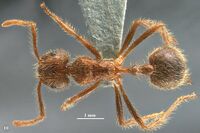Myrmicaria chapmani
| Myrmicaria chapmani | |
|---|---|

| |
| Scientific classification | |
| Kingdom: | Animalia |
| Phylum: | Arthropoda |
| Class: | Insecta |
| Order: | Hymenoptera |
| Family: | Formicidae |
| Subfamily: | Myrmicinae |
| Tribe: | Solenopsidini |
| Genus: | Myrmicaria |
| Species: | M. chapmani |
| Binomial name | |
| Myrmicaria chapmani Zettel, Laciny, Balàka & General, 2018 | |
Myrmicaria chapmani is known from a few localities in the south-eastern part of Negros Island and is the only member of the genus known from the island.
Identification
Zettel et al. (2018) - In exact full-face view, eyes not touching outline of head. Scape relatively short, SI = 92-100. Sides of mesonotum weakly bulging; posterior surface with longitudinal rugae. Medial carina of mesonotum extended onto base of propodeum. Propodeal spines moderately long, slightly directed dorsocaudally, not continuing dorsal outline of propodeum. Peduncle of petiole moderately long. Base of gaster tergite 1 without striation. Gaster usually infuscated except anterior part of tergite 1.
Myrmicaria chapmani is the only known species of its genera known from Negros. The combination of a long median carina on the mesosoma that reaches the base of propodeum and the non-striate base of gaster distinguishes it clearly from Philippine congeners. Due to slightly swollen temples, the eyes are not touching the outline of the head in full-face view. This character is almost unique among Philippine Myrmicaria species (seen also in two aberrant specimens of an undescribed species from Luzon).
Distribution
Distribution based on Regional Taxon Lists
Indo-Australian Region: Philippines (type locality).
Distribution based on AntMaps
Distribution based on AntWeb specimens
Check data from AntWeb
Countries Occupied
| Number of countries occupied by this species based on AntWiki Regional Taxon Lists. In general, fewer countries occupied indicates a narrower range, while more countries indicates a more widespread species. |

|
Estimated Abundance
| Relative abundance based on number of AntMaps records per species (this species within the purple bar). Fewer records (to the left) indicates a less abundant/encountered species while more records (to the right) indicates more abundant/encountered species. |

|
Biology
Castes
Worker
 
| |
| . | |
Nomenclature
The following information is derived from Barry Bolton's Online Catalogue of the Ants of the World.
- chapmani. Myrmicaria chapmani Zettel, Laciny, Balàka & General, 2018: 616, figs. 9-12, 19 (w.) PHILIPPINES (Negros Island).
Unless otherwise noted the text for the remainder of this section is reported from the publication that includes the original description.
Description
Worker
Holotype: HW 1.40; HL 1.36; SL 1.35; SW 0.14; TL 6.20; Pmin 0.16; PW 0.40; PPW 0.41; SpD 0.42; PrL 0.87; FeL 1.92; ML 1.79; PnW 1.01; CI 103; SI 96; FeI 137. Paratypes: min-max (n = 31): HW 1.25-1.51; HL 1.22-1.49; SL 1.24-1.43; SW 0.12-0.16; TL 5.35-6.85; Pmin 0.13-0.21; PW 0.35-0.42; PPW 0.36-0.45; SpD 0.36-0.46; PrL 0.77-1.01; FeL 1.73-2.09; ML 1.57- 1.99; PnW 0.85-1.14; CI 99-110; SI 92-100; FeI 125-143.
Structures: Head roundish to slightly transverse; posteriorly with strong piliferous punctures; most areas dorsally and laterally with relatively strong longitudinal rugae. Temples slightly swollen; eyes not touching outline of head in exact full-face view. Clypeus with distinct, complete median carina and few longitudinal rugae. Mandible with sharp longitudinal rugae; apical margin with four teeth. Entire mesosoma, dorsally and laterally, with predominantly longitudinal rugae, with very few transverse elements, except for the strong transverse ridge at midline of mesonotum and a second (often complete) ridge near its anterior margin. A strong median carina from anterior margin of pronotum onto base of propodeum. Pronotum with relatively short, rather ventrally directed teeth that are weakly protruding laterally. Sides of mesonotum slightly bulging. Metanotal groove narrow and deep, in dorsolateral view lateral margin forming a very obtuse angle. On propodeum, the area between bases of spines moderately concave. Propodeal spines moderately long, directed strongly upwards, slightly diverging. Nodes of petiole and postpetiole rounded; peduncle of petiole comparatively short. Gaster with piliferous punctures; base of gaster tergite 1 without striation.
Setae abundant on trunk and appendages. Dorsal setiferation composed of two types of setae; short setae about half as long as long ones (but somewhat longer on gaster). On head dorsum, petiole and postpetiole all setae suberect. Short setae abundant on mesosoma sides, but scarce on its dorsum. On gaster, long setae suberect, short setae subdecumbent anteriorly, suberect posteriorly.
Colour of trunk yellowish brown, except gaster more strongly infuscated. In many paratypes, trunk yellow, obviously faded from previous storage in ethanol. All appendages yellow. All setae pale yellow.
Type Material
Holotype (worker) (National Museum of Natural History) from Negros Island, Negros Oriental Province, Sibulan, Lake Balinsasayao – Lake Danao area, 28–30 October. Paratypes: 19 workers (Naturhistorisches Museum Wien, Vienna, Herbert and S.V. Zettel) from the same sample; 1 worker Template:(MCZ), Negros Island, Negros Oriental Province, Dumaguete, “Lake Bell’s cabin”, coll. J.W. Chapman, 22 May 1940; 6 workers (MCZ), Dumaguete, coll. J.W. Chapman, 29 March 1924; 5 workers (MCZ), same locality and collector; 9 workers (MCZ), same locality and collector, except 1,000–1,500 ft. a.s.l.; 5 workers (MCZ), same locality and collector, except 1,500 ft. a.s.l.; 3 workers (MCZ) same locality and collector, except 2,000 ft.
Etymology
Named after James Wittenmyer Chapman (1880-1964), myrmecologist at Silliman University, Dumaguete, Negros Oriental, and at Harvard University, to honour his passionate dedication to science and his sense of social responsibility.

